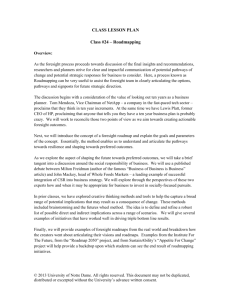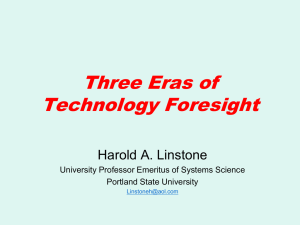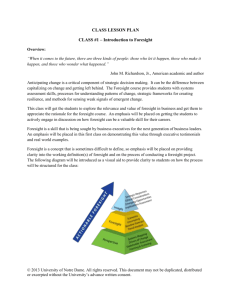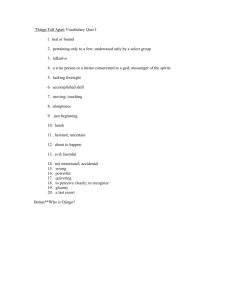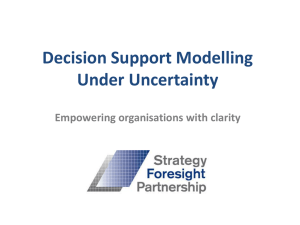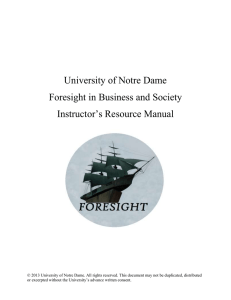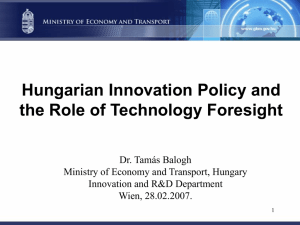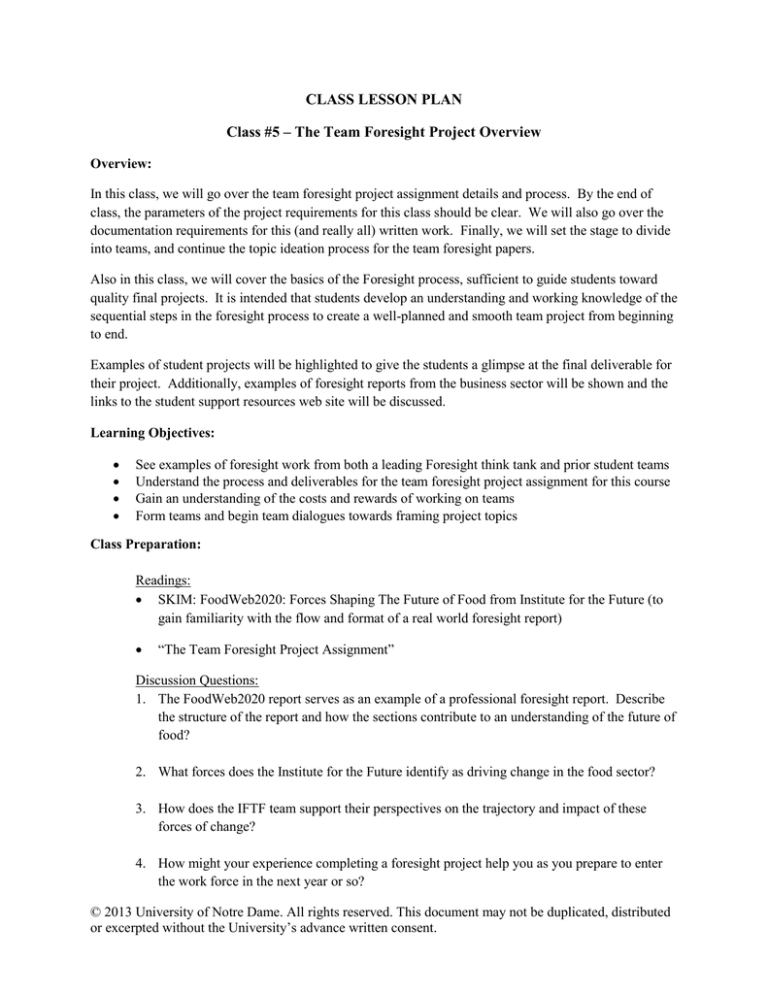
CLASS LESSON PLAN
Class #5 – The Team Foresight Project Overview
Overview:
In this class, we will go over the team foresight project assignment details and process. By the end of
class, the parameters of the project requirements for this class should be clear. We will also go over the
documentation requirements for this (and really all) written work. Finally, we will set the stage to divide
into teams, and continue the topic ideation process for the team foresight papers.
Also in this class, we will cover the basics of the Foresight process, sufficient to guide students toward
quality final projects. It is intended that students develop an understanding and working knowledge of the
sequential steps in the foresight process to create a well-planned and smooth team project from beginning
to end.
Examples of student projects will be highlighted to give the students a glimpse at the final deliverable for
their project. Additionally, examples of foresight reports from the business sector will be shown and the
links to the student support resources web site will be discussed.
Learning Objectives:
See examples of foresight work from both a leading Foresight think tank and prior student teams
Understand the process and deliverables for the team foresight project assignment for this course
Gain an understanding of the costs and rewards of working on teams
Form teams and begin team dialogues towards framing project topics
Class Preparation:
Readings:
SKIM: FoodWeb2020: Forces Shaping The Future of Food from Institute for the Future (to
gain familiarity with the flow and format of a real world foresight report)
“The Team Foresight Project Assignment”
Discussion Questions:
1. The FoodWeb2020 report serves as an example of a professional foresight report. Describe
the structure of the report and how the sections contribute to an understanding of the future of
food?
2. What forces does the Institute for the Future identify as driving change in the food sector?
3. How does the IFTF team support their perspectives on the trajectory and impact of these
forces of change?
4. How might your experience completing a foresight project help you as you prepare to enter
the work force in the next year or so?
© 2013 University of Notre Dame. All rights reserved. This document may not be duplicated, distributed
or excerpted without the University’s advance written consent.
5. What are the challenges of working in a team setting on a complex project?
6. What are the advantages of working in a team setting on a complex project?
Assignments Due: None
© 2013 University of Notre Dame. All rights reserved. This document may not be duplicated, distributed
or excerpted without the University’s advance written consent.
INSTRUCTOR GUIDELINES
Discussion Launchers:
Revisit the question from the prior class regarding whether we are on the verge of a collective awakening
of the magnitude of the renaissance. Use polleverywhere to get them to go on record, then start a
discussion regarding, not necessarily whether we are but rather how we will know how this is playing out.
What will need to change in order for the awakening to be of such magnitude? What will the early
indicators be? Allow the students to discuss in triads to create better informed answers.
“What do you want to gain from taking Foresight?” Ask the students to consider what they are hoping to
gain out of this class. Get a brief discussion going on their perspectives and then transition into how the
foresight project can help deliver on some of those expectations.
Discussion Questions with Answers:
1. The FoodWeb2020 report serves as an example of a professional foresight report. Describe the
structure of the report and how the various sections contribute to an understanding of the future of
food?
A: The report structure is as follows:
Executive summary concisely providing the insights of the report
Introduction and systems assessment
“Disruptions” section outlining the 8 forces shaping the future of the food
“Innovations” outlining the responses from various stakeholders
“Forecasts” outlining the projected shifts in the direction of the sector
“Implications” on the consequences of the shifts/forecasts
“How To Use This Report” which outlines possible response strategies to create
resilience
Also see the FoodWeb2020 map, which is similar to the poster deliverable for this
foresight course
2. What forces does the Institute for the Future identify as driving change in the food sector?
A: The report spells out 8 driving forces as follows:
1. New Taste Imperatives, including increasingly luxurious expectations such as mangos in
the winter, and increasingly strained resources caused by these expectations
2. Growing Food Fears, including the systemic risks caused by increasing system
complexity, and Splintering trust caused by high profile system breakdowns (e.g. e coli)
3. New Attention To Health Impacts, including Problems of Plenty (e.g. obesity), and
Augmentation Diets which refers to using diet to achieve a health benefit (e.g. improved
digestion)
4. Upsurge In Food Rights Activism, including Local Empowerment for local selfsufficiency, and Remote Land Control which refers to foreign powers buying or leasing
control of land from larger, less wealthy countries.
© 2013 University of Notre Dame. All rights reserved. This document may not be duplicated, distributed
or excerpted without the University’s advance written consent.
5. Increasing Cost Volatilities, including Interconnected Volatilities such as the food vs. fuel
dilemma, and Uncertain Supplies strained by global forces
6. Cascading Environmental Emergencies, including Perilous World impacted by uncertain
climate change events, and Water Rights amid growing water conflict
7. Growing Demand For Sustainability Metrics including Food Footprints that include
externalities, and Life-Cycle Labels to better inform consumers at the point of purchase
8. Expanding Push Toward Carbon Neutrality including Community Food Production to
reduce transportation impacts, and competing Land Uses as fuel competes with food in
terms of land use.
3. How does the IFTF team support their perspectives on these forces of change?
A: For each of the forces of change, the IFTF team presents evidence to support their points. On
each page they provide data analysis to reinforce the points that they make. Their choice of
indicators and analysis is well defined, and the fit with their argument is strong. Take note of the
clean flow and format of their report structure, which adds impact to their argument.
4. How might your experience completing a foresight project help you as you prepare to enter the
work force in the next year or so?
A: Student intentions will be diverse, so plan to take time to get some perspectives into
discussion. Then get more specific in regard to how the deep-dive project can help them
achieve their objectives. Here are a few possible talking points:
Developing experience in scanning can be useful for helping them to identify which
areas of the companies they go to work for are likely to experience the fastest growth,
and therefore there most lucrative advancement opportunities
Gaining experience in foresight forecasting can be useful in demonstrating strategic
analysis skills that are valuable for supporting decision making in business
Assessing business implications will demonstrate the ability to generate useful
insights from research, which is a key stepping stone into leadership in business
This project can serve as a great discussion topic during the interview process,
demonstrating the ability to explore uncertain future topics of high complexity and
business relevance – in a team situation.
5. What are the challenges of working in a team setting on a complex project?
A: Working on teams adds another dimension to the complexity of the project. Specifically,
the challenges of working on teams include:
Conflict
Scheduling and Time Management
Prioritization
Accountability
Some may prefer to just hunker down and do the work themselves, however learning how to
overcome these challenges will be an essential survival skill in the business world.
© 2013 University of Notre Dame. All rights reserved. This document may not be duplicated, distributed
or excerpted without the University’s advance written consent.
6. What are the advantages of working in a team setting on a complex project?
A: Teams provide better perspective as a result of the diversity of background and knowledge
of the team members. Diverse teams lead to better decisions. Teams also allow for the
workload to be divided and allow for the outcome of a project to be much more impactful.
This division of work can be especially important when team members have varying schedule
conflicts – keeping the progress moving more steadily. Finally, accountability across the
team drives performance.
7. What are the major components of the foresight paper you will complete for this class?
A: This project will progress along several stepping stones towards the final report and
presentation. Along the way student teams will be expected to complete the following:
Scope of Project Brief (w/ elevator speech)
Current Assessment
Trend Analysis Strategy (w/ elevator speech)
Trend Analysis and Foresight Forecast
First Draft
Peer review of another team’s first draft
Final Draft
Final Presentation
For the paper itself, the components are as follows:
Executive Summary
Abstract
Introduction
Topic in Context
Evidence-Based Foresight Forecast
Insights and Implications for Business
Conclusion
Citations
8. There is an emphasis being placed on citations and avoidance of plagiarism on this project. Why
is this aspect being emphasized in this class?
A: In this class, you are challenged to generate insights based on information that has been
created by others. You will do no primary research, and much of the situational assessment
you develop will be based on the efforts of others. This is a common practice in business and
you are encouraged to include the best information available. However, this challenge puts
you directly in harms way to inadvertently imply that the content you are presenting is your
own when it is in fact the work of others. For this reason, an emphasis on ensuring that all
sources are appropriately cited is critical. In business, there is a secondary value to
complete and accurate citations – these will serve as your bread crumbs back to the original
report or data source – which you will inevitably need to revisit for follow on analysis. Not
being able to retrace your footsteps can cost a lot of time and effort, and reduces the value of
your work.
© 2013 University of Notre Dame. All rights reserved. This document may not be duplicated, distributed
or excerpted without the University’s advance written consent.
Class Timeline:
5 Minutes – Quote of the Day and Intro
10 minutes: Intro and Discussion of FoodWeb2020
15 Minutes – Overview of the Foresight Project Assignment and Timeline
10 Minutes – Examples from Business and Student Support Resources Web Site
5 Minutes – Team Selections Announced
10 Minutes – Value and Costs of Working on Teams
15 Minutes – Initial Team Discussions
5 Minutes – Wrap Up and Preview of Upcoming Class
Classroom Activities / Short Assignments:
Once teams are announced, each team will gather and have an introductory discussion to get the
ball rolling on building a favorable team dynamic and begin the topic selection process. Have
students exchange contact information, schedules, etc.
Give the student teams time to get the ball rolling towards their topic definition and aim towards
the Scope of Project Brief assignment. There will be another, longer opportunity one week later
during the project development workshop in Class 7.
Multimedia Supplements:
Web video links from prior team projects
Cover slides from selected prior team projects
Poster samples from prior semester
Student Resources Web Portal to highlight additional sample projects
Web video on high performing teams (link)
© 2013 University of Notre Dame. All rights reserved. This document may not be duplicated, distributed
or excerpted without the University’s advance written consent.

